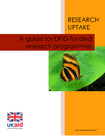Research Uptake Guidance - DFID
“Research uptake requires adequate supply of and demand for research. Research uptake strategies should encompass stakeholder engagement, capacity building, communication and monitoring and evaluation.”
DFID Research Uptake Guidance (2013: 1)
Organization: DFID
Year: 2013

Purpose:
- Provides practical advice for designing a research uptake strategy
Content:
- Strands of Research Uptake: 1) Stakeholder Engagement; 2) Capacity Building; 3) Communicating; 3) Monitoring and Evaluation
- Includes different case studies
- Research Uptake Checklist
Toolkit & Step by Step guide to get evidence into policy and practice - 3ie
Organization:
- International Initiative for Impact Evaluations (3ie) and the Overseas Development Institute (ODI)
Purpose:
- Designed to support evaluators and researchers who are committed to engaging with decision makers to see the evidence from their studies used to build better policies and programmes.

Content:
- Step-by-step tutorial guide to develop a comprehensive policy influence plan: context, risks, policy objectives, stakeholder analysis, key influencers, theory of change, engagement plan, budget, evaluation and learning
- Includes a Policy Influence Plan Format http://policyimpacttoolkit.squarespace.com/storage/documents/2012_PIP_template.docx
Promoting the use of knowledge in policy and practice - WHO
Organization: Alliance for Health Policy and Systems Research / WHO
Year: 2004
Purpose:
- Promoting the generation and use of health policy and systems research (HPSR) as a means to improve health and health systems in developing countries.
- Developing and harnessing existing methods and approaches to improve both the quality of research and its ultimate uptake.
Content:
- Module 3: Promoting the use of knowledge in policy and practice: Introduction, Communicating knowledge, Advocacy, Knowledge Networks, Electronic tools for managing knowledge, Local knowledge
Development Research Uptake in Sub-Saharan Africa - DRUSSA
Organisation:
- DRUSSA- Development Research Uptake in Sub-Saharan Africa
- Funded by DFID
Year: launched in June 2013

Purpose:
- To address the need for an African science news service
- To equip universities in the region with the capacity, knowledge and tools to get their research to policymakers and the general public for more effective dissemination
Content:
- includes links to different tools and tips for research uptake
Research Uptake Strategy - R2A
Organization: Research To Action (R2A)
Year: 2012
Purpose:
- Initiative to improve the way social, economic and environmental development research is communi-cated and utilized.
Content:
- Guides and toolkits for creating uptake (or communications) strategies.

“An Uptake Strategy is a planning tool that will help you to meet your goals and objectives. It should complement your project strategy, and use the objectives and indicators that you identified in your logframe or theory of change. It is not a dissemination checklist. The key elements of your uptake strategy are similar to any other strategy: What do you want to accomplish (objective)? Who do you need to communicate with in order to achieve those objectives (audience)? What do you want that audience to do (or know, etc.)? What do they do/know now (your baseline)? How will you measure your progress (indicators)? What resources do you have or need? Once you agree those basics, you can choose the tools that you can use, and tailor your information for each audience, starting with those who are most able to make happen the change that you seek.”
(Research To Action)
